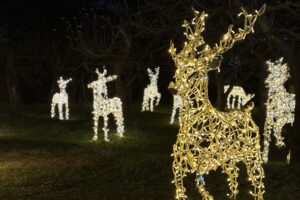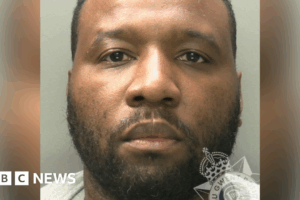
Germany’s infamous symbol of division, the Berlin Wall, split West Berlin — an isolated enclave of the Federal Republic of Germany (FRG) — from East Berlin, in the German Democratic Republic (GDR) for 28 years.
Construction began in 1961 under the orders of the GDR’s communist leadership, following the flight of approximately three million people to the West. They were escaping a struggling economy, limited freedoms and government surveillance. To prevent further defection to the West, the East German government built a complex system of barriers, obstacles and guard towers along the 155-kilometer-long border.
It was meant to be impenetrable — although some 5,000 East Germans did manage to make it across over the years.
Marking the divide: The Berlin Wall Memorial
To view this video please enable JavaScript, and consider upgrading to a web browser that supports HTML5 video
The wall cut nearly all traffic routes and communication channels between East and West Berlin. Border-crossing points such as Checkpoint Charlie remained exceptions.
At the wall, the GDR’s cruelty was put on full display. Between 1961 and 1989, at least 140 people were killed there. In addition to around 100 individuals attempting to flee, border guards and uninvolved passersby also lost their lives.
How the Berlin Wall became a coveted memorial
When the communist block collapsed in Eastern Europe, the Berlin Wall fell with it on November 9, 1989. German reunification then followed about a year later.
People celebrating the fall of the Berlin Wall in November 1989Image: Peter Kneffel/dpa/picture alliance
Today, only some segments of the wall are left standing in Berlin.
The longest is the famous East Side Gallery, with its painted-concrete structure spanning 1.3 kilometers (0.8 miles). Another section can be found at the Berlin Wall Memorial.
When the Berlin Wall fell, the people of Berlin were eager to dismantle the repressive structure as quickly as possible. At the same time, individuals, governments and institutions around the world were keen to acquire pieces of it. The US, in particular, were very interested in obtaining segments of the wall.
According to estimates by the Federal Foundation for the Study of the Communist Dictatorship in Eastern Germany, the US has more pieces of the wall than Berlin does. Whether in front of the CIA headquarters in Langley or in a men’s restroom in Las Vegas, the Berlin Wall can be found all over the country.
A section of the Berlin Wall stands next to the United Nations main building in New York CityImage: Giuliana Neumann/Bundesstiftung Aufarbeitung
“As one of the victors, of course the US played a major part when it came to divided Germany,” explained the director of the foundation, Anna Kaminsky.
“The wall was a topic nearly all American presidents referred to in foreign policy. It was basically an emotional issue for the US — especially for US soldiers who were stationed in Berlin.”
Parts of the wall are scattered not just across the US but the globe — from New Zealand to Iceland and from Indonesia to Chile. The German foundation has identified 57 countries (besides Germany) where there is at least one piece. Each one has its own story, and each is interpreted differently. Sometimes it was private people or companies that acquired the segments, while other times the German government or Berlin Senate gifted them.
As a memorial and a plea for unification
In South Korea, where ties can be felt with German history due to the country’s separation from the North, there are pieces of the wall at six different places, including Dorasan, the northernmost point of the South Korean railway network, along the North Korean border. In 2015, at the train station there, then-serving German President Joachim Gauck joined South Korean government representatives in opening the “Unification Platform” and revealing a wall segment along with a plaque calling to “Create a reunited Korea and help the world become more peaceful.” In addition, there is a quote by Gauck inscribed: “To find and create a life of freedom together.”
The inauguration of Unification Platform at Dorasan Station: The monument represents South Korean people’s yearning for inter-Korean unification and is equipped with part of the Berlin WallImage: Yonhap/EPA/dpa/picture alliance
The pieces of wall in some countries of the former Eastern Bloc seem to bear special significance, where they symbolize hard-won democracy.
That’s the case in Bulgaria, where the municipal government of Sofia asked the Berlin Senate for a piece of the wall in 2006. It now stands next to the memorial to victims of communism in Bulgaria and is accompanied by two plaques inscribed with text in Bulgarian and German reading, “On August 13, 1961, a wall divided Berlin and Germany, and thus Europe and the world. Bulgaria remained trapped on the east side of the wall — until November 9, 1989, when the people brought it down. This segment of the Berlin Wall is a gift from Berlin to the citizens of Sofia — as a sign of reunified Europe and proof that the Bulgarians are now free.”
The sober memorial in Sofia, BulgariaImage: Ulrich Mählert/Bundesstiftung Aufarbeitung
The wall section in Sofia is dull and grey — just like the real wall was. Many other parts, however, have been painted or tagged with graffiti — often revealing good intentions, with symbols of peace and friendship. Today, they now seem more like a piece of pop culture than the one-time components of a dreaded border wall.
French artist and Berliner-by-choice Thierry Noir painted the wall on the West Berlin side with large-scale figures typical of his work even before November 9, 1989. But he later permanently left his mark on the segments.
The head of “Germany’s Next Topmodel,” Heidi Klum, has a piece of the wall painted by him standing in her yard in California. It was a gift from her husband, who was born in East Germany.
Controversy: Wall sections sold for profit
After the wall fell, the transitional government of the GDR at the time tasked a publicly-owned company with selling the remains of the structure for a profit. That company, in turn, collaborated with a West Berlin agency. Together, they decided to paint the segments to enhance their attractiveness and boost sales prices. “That stirred up a great deal of protest — to see the GDR government, along with party representatives, who had built the wall where so many people died, were now wanting to even turn a profit by selling it,” explains Anna Kaminsky. However, the sale was at least meant to benefit non-profit institutions. But even private companies made profits with the wall.
A work criticizing this practice can be found in the Norwegian city of Trondheim. There, artist Lars O. Ramberg created a sculpture titled “Kapitalistischer Realismus” (Capitalist Realism) for the municipal government. On the wall segment, he placed the word, “SALE.” The Berlin Wall symbolizes the achievement of freedom and also serves as an example of how this symbolic value is up for purchase, the artist explained, adding that he was casting himself as part of this problem by having acquired wall segments and creating the sculpture.
‘SALE’: A piece of the Berlin Wall, turned artwork, at the Trondheim Museum in Norway Image: Karoline Punke/Bundesstiftung Aufarbeitung
In the past 10 years, requests for pieces of the wall have dropped significantly. “World history has gone on, and global politics are different,” says Anna Kaminsky. “The iconic impact of the wall has receded over the decades. It is increasingly losing its place as a symbol.”
Some say this has its positive aspects, too — because no matter how colorful it is or where it stands, the wall remains a symbol of dictatorship.
This article was originally written in German.





